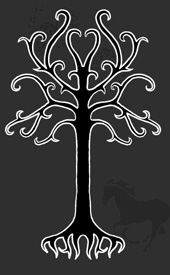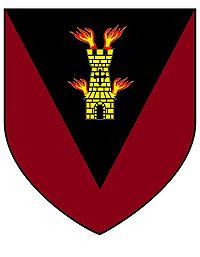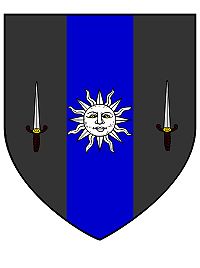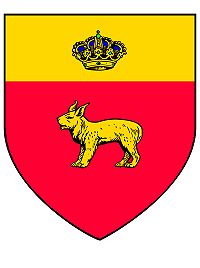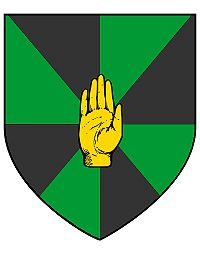The Emperor's Blades or Imperial Blades is the primary military force of the Empire of Fastheld. Being an Imperial institution, it reports directly to His Highness, Emperor Talus Kahar XIV. It provides the backbone of security for the state and is well trained, well equipped and well led to accomplish its purposes. While its numbers vary according to many concerns, it hovers around 5,500 trained Blades. Due to its small size and completely volunteer nature, the Imperial Blades work very closely with the nobility's House Guards, the Market District's Guild Militia, as well as local constabulary authorities. Soldiers initially sign up for terms of five years and many of those who do sign up, both Noble and Freelander, will leave after their contracts lapse. However, there is a strong corps of professional career soldiers who stay on for full terms of twenty years, which makes one eligible for pension. The Blades draw their strength and backbone from these career soldiers. The Blades only recruit men.
For more information on how the Blades interact with the realm at whole and other martial groups, see Fastheld Military.
Contents
Organization
Ranks
The Blades' ranking structure is designed to encourage skilled soldiers in pursuing advancement, with a focus on effective unit leadership, while recognizing the oft-held maxim that nobility are inherently ready to lead troops right away.
Soldiers
- Recruit - Everybody first joining the Blades holds this rank while they are trained, though nobles and freelanders are not trained together. A Blade joins for an initial term of five years.
- Guardian - This is the rank where freelanders start after they've completed their training. The Guardian is the most common rank in the military, and many of those who join the Blades never move up past it. However, freelanders who stay in past their initial five year terms tend to advance past this rank.
Non-Commissioned Officers
- Corporal - If a Guardian shows skill and leadership abilities, it is possible for them to move up to the rank of Corporal. They command a squad of ten men. This is a commonly held rank for those freelanders who stay on past their initial five years in the Blades, and due to their experience and time in they are favoured as leaders for lower ranking troops. Corporal is also considered a 'working' rank in the military for those who are career soldiers. Once the rank is achieved, it is possible to be posted nearly anywhere in the realm.
- Sergeant - Corporals who distinguish themselves further, show a talent for organization as well as leadership and have significant experience can advance to the rank of Sergeant. They command a platoon of several squads.
- Bladesman - This is the rank which nobility are given after their training. Due to their better birth, education and means, Bladesmen are given command of a ten man squad immediately. They can move up to command a platoon of several squads, though unlike freelanders they retain the same rank, which denotes their higher social status.
Though a Bladesman is given an initial higher rank due to his birth, this does not mean that he will not serve as a squad leader under a senior freelander Sergeant, a situation which is common enough not to warrant second thoughts. In cases where a freelander commands a noble, he is to be shown the same deference that the noble would show to any superior, and be addressed as "Sir" or "Sergeant". The same goes for freelander Corporals serving as squad leaders under a Bladesman who command their platoon.
(Originally, the rank Guardian Leader fulfilled the jobs of both Corporal and Sergeant, but this was changed in a minor reform in 623 ATA.)
Officers
- Marshal - Marshals typically command a Company's worth of troops, which is made up of several platoons. Due to their experience, they can and are also posted around the realm on staff duties, as area commanders, or liason officers with other elements of Fastheld's society. While mostly noble, there are a minority of freelander Marshals, promoted for their great skill and leadership abilities.
- Captain - Captains command Regiments, Districts and serve as senior staff officers. Only those who have accumulated a great amount of experience and demonstrated ample ability to organize and lead soldiers are promoted to this rank, which occupies the upper echelons of the Blades.
Command
- 2nd Blademaster - This is the second in command of the Blades, and almost always is the Blademaster in waiting.
- Blademaster - The commander of the Emperor's Blades. He reports directly to the Emperor.
Branches
There are five trades within the Emperor's Blades.
- Infantry - These soldiers fight most often with sword, shield and spear. They are trained for close order combat in formation as well as individual fighting. They are the most numerous of the Emperor's Blades, and the most often seen.
- Archer - These men work in close concert with the infantry in most situations, and are armed with bows, though they have the means to defend themselves up close.
- Cavalry - Trained to be quick shock cavalry, messengers and scouts, the cavalry arm of the Blades are generally equipped as a medium cavalry, highly versatile and mobile.
- Engineer - Oft overlooked, the Imperial Corps of Engineers is an extremely important part of the Emperor's Blades. From building fortifications, operating the seldomly seen artillery pieces, repairing the Aegis and working on roads, Engineers are always very busy. They are also known as sappers. Imperial weapon and armour smiths are posted to the Engineer branch, as well as most other similarly skilled trades.
- Medical - Medics are attached directly to the larger fighting units, as well as serving at higher headquarters. They are uniformly trained in their job and considered very skilled.
Structure
The Emperor's Blades are formed into four distinct regiments, corresponding to the four garrisons of Fastheld. Each regiment has what it considers to be an "elite company", made up of its shock troops. Originally there were ten regiments throughout the realm, but these were amalgamated or disbanded over time. Every member of the Emperor's Blades has a home regiment, that which they started in. Unless they're posted in a command position of another regiment's troops, they keep their affiliation with their home regiment throughout their career. Affiliation is shown by their shield's coat of arms or a small metal badge with the regiment's insignia that can be pinned on one's helmet, when in armour, or tunic when out of armour.
Each regiment contains Blades from all of the trades - whether infantry, archers, cavalry, engineers or medics. They are organized in a simple manner.
- Squad - Around ten Blades, commanded by a Bladesman (noble) or a Corporal (freelander).
- Platoon - Usually three squads, two of infantry and one archer, and a headquarters element that includes flag and horn signallers. Commanded by a senior Bladesman (noble) or a Sergeant (freelander).
- Company - Comprised of three platoons, a small cavalry section and a headquarters. Commanded by a Marshal, they also include a small medical detachment and often some engineers. Companies are designed so that they can be posted out of the garrison and operate on their own for extended periods of time. Most of the companies are named and have proud, documented histories.
- Regiment - There are six standard companies in each regiment, as well as sizable separate Cavalry, Engineer and Logistics Wings. They are commanded by Captains. Each regiment is posted to one of the Empire's garrisons.
Imperial General Staff
The Imperial General Staff was created after the chaos of the Second Wildling War (611 ATA), where a largely unprepared military was caught completely unawares by the viscous assault of the Realm's traditional enemies, the Wildlings. During the widespread reforms of the Blades which followed the successful conclusion of the war, many traditional and inflexible structures of the Blades were abolished and new positions were created to make sure that stagnation did not once again set in.
One of these innovations was the Imperial General Staff, a collection of senior officers of Captain and Marshal grade who were initially assembled to study lessons learned of the War and apply them to the Blades organization. Some of these soldiers were called out of retirement to serve on the Staff, while many others were simply promoted to fill out positions. They were all veterans of the War. The Blademaster at the time, Felisin Mikin, was so impressed by the progress and utility of having a senior cadre on hand at all times that he made the Staff a permanent fixture of the Blades. Their role quickly expanded from simply studying the War to moving at the forefront of both intelligent reformation, the study of the Blades' institutional history, tactical as well as strategic procedure, and finally judging the progression of individual units within.
One of the most important positions on the staff is that of the Imperial Inspector of Troops.
The General Staff's membership, including all officers and junior soldiers attached, usually hovers around one hundred men. These men are pulled from all four of the regiments. Working for the General Staff is considered very prestigious and a good way to secure one's advancement. There are also members of other organizations who are posted within the General Staff as liaison, such as Shadowscourges and senior members of House Guards, among others.
Members and former members of the General Staff are entitled to wear a broad crimson stripe on both sides of their tunics, as well as a crimson stripe on the top corner of their shields. This regulation goes for both officers (Captains and Marshals) as well as other ranks. Non-Blades members of the General Staff are also authorized to wear these stripes, both during and after their assignment is up.
In addition, several pieces of new equipment have made their way to member's of the staff as well as elite Companies within the Blades, such as the new segmented plate armour.
History
Foundation
The Emperor's Blades were created in 4 BTA (Before The Aegis) by the first Emperor of Fastheld, Talus Kahar I, and Ulfell Lomasa, who went on to be the first Blademaster. The original organization was not much more than a patchwork volunteer force of those who chose to stand with the Emperor during the Darkening of Fastheld. As the war evolved, it amalgamated several of Fastheld's military forces, primarily those from the noble houses. It was during the First Wildling War that the Blades' history was forged and on a successful conclusion of the war it was organized as a permanent standing military.
The questions of how the new military was to be organized went to the wayside, somewhat, in the years following extensive rebuilding of the Empire. The Blades remained somewhat of an ad-hoc organization, as the nobility squabbled over their rights to defense and the ability to recall the troops whom they had volunteered for Imperial service.
First Reforms
It was not until Blademaster Serus Kahar was to take command of the Blades in 8 ATA that the structure of the Empire's military would be firmly established. Very quickly, he instituted order in an institution which had begun to break down in a squabbling over jurisdictions. Serus Kahar rolled out a new, unified ranking structure for the soldiers, delineated the differences in trades within the military and authorized the founding of ten distinct regiments to operate within different areas of the Empire. As time went on, most of these regiments would be disbanded and amalgamated to make up the four which currently operate in Fastheld.
These reforms swept away the last vestiges of the Old City Guard which had been the only previous universal militia, and removed any traces of the myriad of noble house guards. Not surprisingly, these reforms provoked widespread discontent through many in the ranks, which was cracked down upon severely by the senior leadership. Within the space of a year, though, any real sort of resistance to the changes was gone and especially those who had been former members of the disbanded minor noble houses became enthusiastic supporters of the Imperial military.
Early Days
For the next few centuries, the Blades were busy mainly with policing duties within Fastheld as well as fighting small insurrection, usually provoked by those claiming noble status in one of the former minor houses and wanting to grab a piece of the mostly virginal land within Fastheld for themselves. Logistical planning and organization was unfortunately rather haphazard and rarely efficient. There were also a surplus of regiments, most of them understrength and representing Blades of only one trade, which made interoperability between the different units very difficult. It was in the early days that personal feuds between the Captains of different regiments soon caused regimental feuds which would affect cooperation between these units.
Their lack of personnel, lack of funds, poor logistical organization and rigid structures slowly set into place – however, because of the lack of serious adversity, this wasn't brought to the forefront of the Imperial agenda until the mid 170s ATA, when Talus Kahar V created a unit of elite horsemen called the “Swift Blades” in order to have a fast responding, cohesive unit for employment. Unfortunately, the rest of the Blades organization would remain neglected for the next through years. This was to have terrible consequences.
The Quarantine & The Purge
With the terrible Shadow Plague sweeping the Old City in the early fall of 182 ATA, the Emperor had tried to contain the disease by traditional mans. However, within a few months it became obvious that the efforts were not achieving any real results and that the disease continued to spread. Mid winter 183 ATA, Emperor Talus Kahar V made an incredibly difficult decision to send most of the Emperor's Blades into the Old City to force a quarantine – that is, to kill any men, women and children they found, whether these citizens manifested signs and symptoms of the Shadow Plague or not.
Bolstered by his advisers' opinions that the might of the Blades would soon quickly crush the disease without any trouble, the Emperor turned the campaign over to his Captains. There were immediate problems, which began in the realm of supplies. There simply weren't enough – grain and other rations, replacements for tools, boots, arrows, even winter clothing. Nevertheless, the Captains quickly agreed to proceed with the campaign and converged on the Old City, planning on looting whatever supplies they would need. Whatever plans they had for entering the Old City itself quickly went by the wayside and though their breach was unopposed, their initial camp was a staple of the mismanagement of the campaign in its early stages. Each regiment, infantry, cavalry and archers spread out through the Old City to conduct their grizzly tasks, without pausing to mix different types of troops for mutual support.
Despite the blindingly obvious difficulties, the campaign was not planned to react to any sort of resistance. This resistance flared up rather quickly, in an organized fashion, as ex-Blades living in the Old City formed well equipped militia units to defend themselves, and nobles who also lived there rallied their own retainers to arms. Due to the poor inter-service coordination, the Blades were routed decisively in their first few engagements. However, once the Captains recovered and regrouped, they decided to concentrate their soldiers and cut off any avenues of escape from the Old City. For the rest of the winter of 183 ATA, they destroyed several forces of militia opposing them. In the early spring, the last real units of organized resistance were crushed by the Blades at the Battle of Silver Valley. The Blades had at this point lost several thousand soldiers to combat, disease and exposure.
Once the final battle was won, the general carnage began and by early summer the Blades had eradicated any traces of disease, and therefore any real traces of people, other than those very few who were able to hide. The Blades pulled out and the Old City was sealed off – forever to be known as the Shadow District, after the Plague which had begun the campaign.
Aftermath of the Quarantine
The disasters of the Quarantine and Purge were felt strongly by the Blades, who had lost many of their fighting troops. Encouraged strongly by the Emperor in this endeavour, the Blademaster Ralic Nillu got rid of whichever Captains had performed poorly and hadn't already been sacked. He set about instituting serious changes in the way the Blades stockpiled supplies and distributed them throughout the force and disbanded some of the enormously understrength regiments, getting the four which still exist in the present day. Most of the troops who had cut and run repeatedly from battle or shirked from duty were kicked out from the Blades. In addition, he got rid of the conscription of criminals, which he judged to have contributed greatly to the poor performance of the Blades in their first battles.
Still, the Blades of that day were an extremely conservative organization, and in the next centuries there was little chance to prove Blademaster Rallic Nillu's reforms as crucial. Laziness and nepotism crept back into some practices of the Blades over the quiet four centuries which followed. It wasn't until the Second Wildling War that the Blademaster would be vindicated in his beliefs.
This article is a stub. You can help the OtherSpace Wiki by expanding it.
